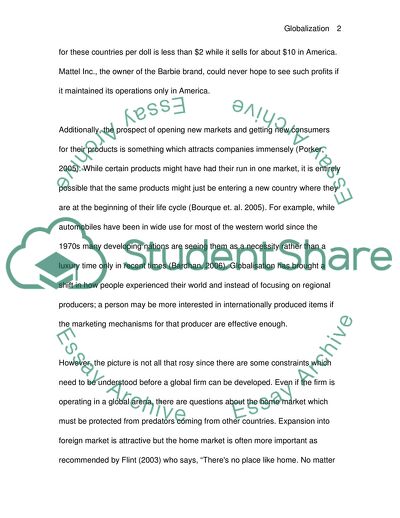
- Home
- Free Samples
- Premium Essays
- Editing Services
- Extra Tools
- Essay Writing Help
- About Us
- Studentshare
- Subjects
- Miscellaneous
- Globalization
Globalization - Essay Example

- Subject: Miscellaneous
- Type: Essay
- Level: Undergraduate
- Pages: 4 (1000 words)
- Downloads: 0
- Author: seamus87
Extract of sample "Globalization"
Goods and services across the world differ in prices depending on the availability of labour and resources. These are inequalities which are difficult to change overnight and nearly impossible to overlook when a company sees the advantages of operating in more than one location simultaneously (Dicken, 2007). Feenstra (1998) gives the example of a Barbie doll and describes in detail how various components of the doll are made in different countries. The raw material comes from Taiwan and Japan, assembly takes place in Indonesia or Malaysia and China supplies the dresses for the dolls.
The total economic input for these countries per doll is less than $2 while it sells for about $10 in America. Mattel Inc., the owner of the Barbie brand, could never hope to see such profits if it maintained its operations only in America. Additionally, the prospect of opening new markets and getting new consumers for their products is something which attracts companies immensely (Porker, 2005). While certain products might have had their run in one market, it is entirely possible that the same products might just be entering a new country where they are at the beginning of their life cycle (Bourque et. al. 2005).
For example, while automobiles have been in wide use for most of the western world since the 1970s many developing nations are seeing them as a necessity rather than a luxury time only in recent times (Bardhan, 2006). Globalisation has brought a shift in how people experienced their world and instead of focusing on regional producers; a person may be more interested in internationally produced items if the marketing mechanisms for that producer are effective enough. However, the picture is not all that rosy since there are some constraints which need to be understood before a global firm can be developed.
Even if the firm is operating in a global arena, there are questions about the home market which must be protected from
...Download file to see next pages Read MoreCHECK THESE SAMPLES OF Globalization
Measuring Globalization
Globalization Strategies
Globalization Reader
Globalization. Globalization In Economic
Globalization and Anti-Globalization
Anti-Globalization Undervaluing the Benefits of Globalization
Various Aspects of Globalization
Media Globalization

- TERMS & CONDITIONS
- PRIVACY POLICY
- COOKIES POLICY